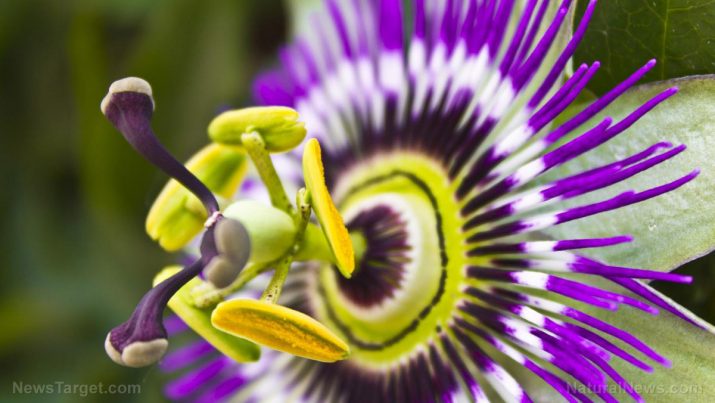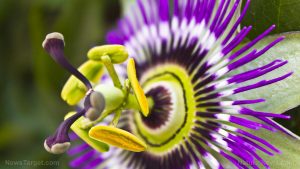
Passion Flower – sources, health benefits, nutrients, uses and constituents at NaturalPedia.com
Friday, August 18, 2017 by Frances Bloomfield
http://www.naturalpedia.com/passion-flower-sources-health-benefits-nutrients-uses-and-constituents-at-naturalpedia-com.html

Passion flower (Passiflora incarnata), or passionflower, is a fast-growing, flowering vine found across the Americas, and sometimes in Australia and Southeast Asia. Numerous cultures value passion flower for its health benefits, of which it has many. In North America and Europe, passion flower is used as a treatment for insomnia and restlessness, while passion flower is considered to be a good wormicide and antispasmodic in Brazil. Passion flower is essentially a plant with multiple health benefits, which will be discussed in greater detail below.

List of known nutrients
The known constituents of passion flower include:
- Amino Acids
- Anthocyanins
- Apigenin
- Coumarin
- Edulilic Acid
- Flavonoids
- Formic Acid
- Glycosides
- Harmaline
- Harmalol
- Harman
- Harmine
- Harmol
- Kaempferol
- Linolenic Acid
- Passiflorin
- Phenolic Compounds
- Quercitin
- Rutin
- Saponaretin
- Vitexin
Passion flower is especially rich in flavonoids, glycosides, amino acids, and phenolic acids. Due to this, this plant has antibacterial, anti-fungal, and analgesic effects, and is typically used as a sedative and an anxiolytic, or a substance that reduces anxiety.
Medicinal uses for passion flower
Passion flower is known to alleviate the symptoms of conditions such as:
- Anxiety
- Constipation
- Coughs
- Dry Throat
- Dysentery
- Dysmenorrhea
- Epilepsy
- Hoarseness
- Hypertension
- Hysteria
- Inflammation
- Insomnia
- Neuralgia
- Parkinson’s Disease
- Premenstrual Syndrome (PMS)
- Shingles
- Ulcers
Low doses of passion flower tea have been linked to better sleep quality. The sedative effects of passion flower extend well beyond that of sleep, as passion flower is thought to help decrease anxiety. This is due to passion flower stimulating the release of a chemical that improves mood, reduces anxiety, and relaxes muscles.
Passion flower can ease the symptoms of premenstrual syndrome, which include anxiety and sleeping difficulties. These symptoms are conditions that passion flower is known to remedy, and so it can be concluded that passion flower may offer relief from premenstrual syndrome too. When combined with St. John’s wort, passion flower can even soothe headaches and mood swings that are commonly associated with menopause thanks to its antispasmodic and sedative effects.
Taking passion flower can help manage the symptoms of hypertension. The effects on blood pressure have been attributed to anthocyanin antioxidant compounds and edulilic acid, as well as the ability of passion flower to increase antioxidant enzyme levels while also lowering the levels of oxidized lipids.
Body systems supported by passion flower
Passion flower is believed to have positive effects on:
- Cardiovascular System
- Digestive System
- Muscles
- Nervous System
Ways to use passion flower
The most common way to take passion flower is as a tea. Apart from this, passion flower can be used in a variety of ways.
Kristin Collins Jackson of Bustle.com outlined five different ways to utilize passion flower and its health benefits: as a salt scrub, body wash, face cream, hair serum, and face steam.
Where to learn more
- 10 Simple Stress Relievers You Actually Want to Do
- Five Herbs that Lower Blood Pressure
- Passion flower is effective for countering anxiety and stress
- Study: Passion Flower Found to be Effective as Synthetic Drugs for Generalized Anxiety Disorder(GAD)
- Using passion flower for anxiety, pain relief and more
Summary
Passion flower is a mild sedative. The leaves are often used to treat insomnia, anxiety, and various other neurological disorders. Moreover, passion flower is believed to lower blood pressure and ease muscle cramps and pains. Due to this, however, passion flower should not be taken by individuals on medication for high blood pressure.
Sources include:
Mdidea.com
EffectiveRemedies.com
HealthyFocus.org
NaturalAlternativeRemedy.com
HealthyEating.SFGate.com
Bustle.com
Tagged Under: Tags: Passion flower





